
Do You Say Hi in India? Greeting Etiquette, Namaste, and What Works in 2025
Wondering if 'hi' works in India? Here’s a clear guide to greetings, namaste vs hello, regional phrases, body language, and business etiquette for 2025.
When you walk into an Indian home or meet someone for the first time, the way you greet can set the tone for the whole interaction. Indians value respect, warmth, and a bit of tradition in everyday greetings. Knowing the basics helps you avoid awkward moments and shows you care about the culture.
The most widely used greeting is Namaste. You press your palms together at chest level, bow slightly, and say "Namaste" or "Namaskar." This simple gesture works in most situations – from business meetings to casual chats with strangers.
In some regions, especially in the south, you might hear Vanakkam or Namaskaram. The hand‑folded gesture stays the same, only the word changes. If you’re in Punjab, a firm handshake is common, often followed by a gentle touch on the shoulder.
When meeting elders, many Indians add a slight head tilt or a deeper bow. Younger folks may offer a light hug or a friendly pat on the back, but only if the relationship feels comfortable. When in doubt, stick with the palm‑fold.
Do maintain eye contact, but don’t stare. A soft gaze shows confidence without being aggressive. Do use the person’s title – "Sir," "Madam," or "Aunty" – especially if they’re older. It signals respect and is well‑received.
Don’t use a Western-style hug or kiss on the cheek unless you know the person well. Physical contact with strangers can feel intrusive. Don’t point your feet at people or religious symbols; feet are considered low, and pointing them can be seen as disrespectful.
If you’re offered a drink or food during a greeting, accept it politely. Declining outright may be taken as rude. You can say, "Thank you, I’ll have a little," if you’re not hungry.
When greeting a group, address the senior member first, then move down the line. This order mirrors the respect hierarchy that’s part of Indian culture. It’s a small detail that makes a big impression.
Learning a few regional phrases can boost your credibility. Saying "Shubh prabhat" (good morning) in Hindi, or "Suprabhat" in Bengali, shows you’ve made an effort. Most people appreciate the attempt, even if your pronunciation isn’t perfect.
In professional settings, a firm handshake combined with a brief "Namaste" works well. Follow the lead of your Indian counterpart; they’ll often adjust their greeting style to match yours.
Remember, greetings are more than words – they’re about posture, tone, and intention. A genuine smile paired with the right gesture goes a long way. If you’re ever unsure, a polite "Namaste" never hurts.
By keeping these simple rules in mind, you’ll navigate Indian greeting etiquette with confidence. Whether you’re traveling, meeting friends, or doing business, a respectful greeting opens doors and builds trust.

Wondering if 'hi' works in India? Here’s a clear guide to greetings, namaste vs hello, regional phrases, body language, and business etiquette for 2025.